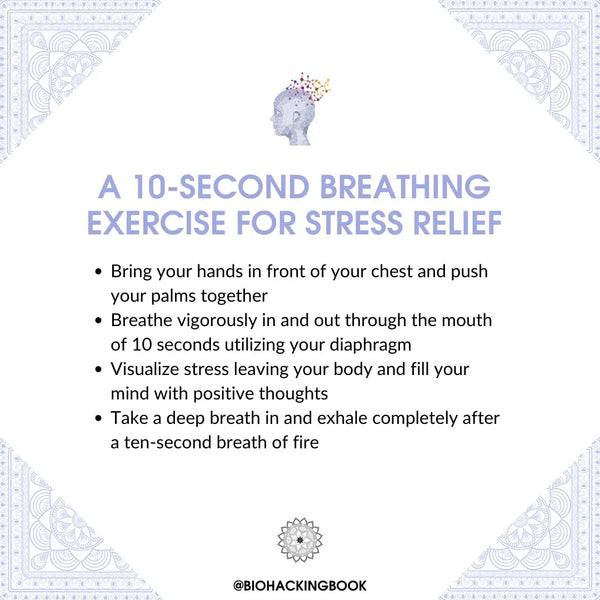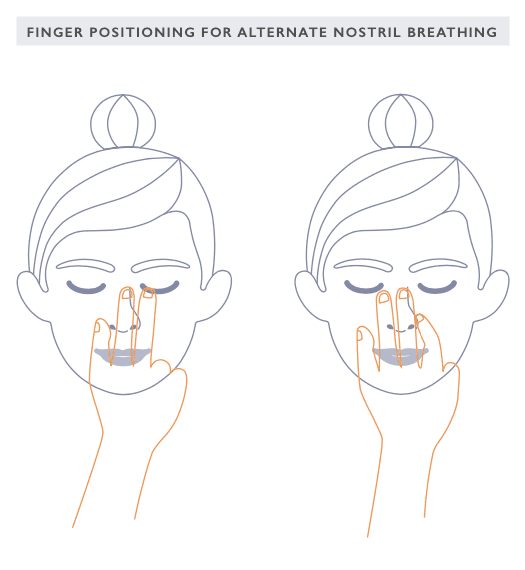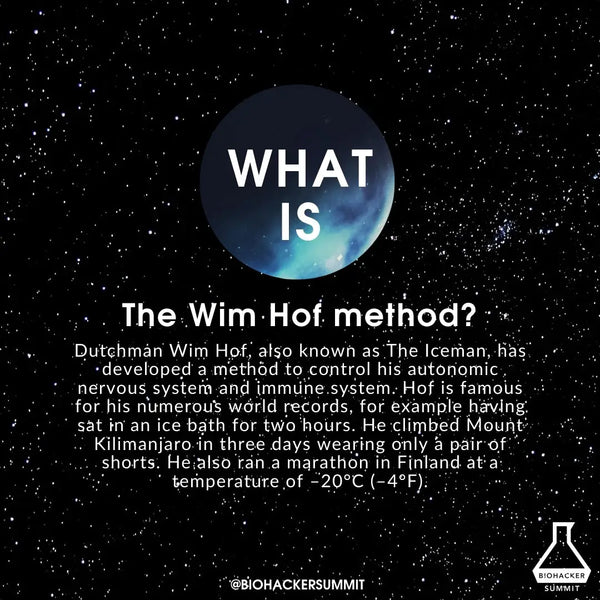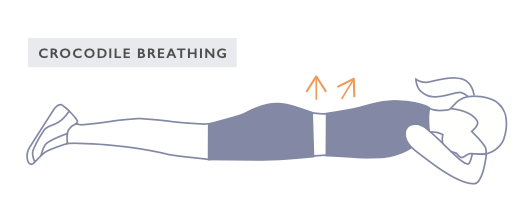Breathing and the regulation thereof have a great impact on the function of the autonomic nervous system. Deep breathing exercises are especially effective in reducing stress and tension. Extended exhalation effectively activates the parasympathetic nervous system which is linked for example to increased relaxation and recovery as well as lowered heart rate and blood pressure.
RESPIRATORY CAPACITY AND TIDAL VOLUME
Studies on mammals have found that the respiratory rate of each species (i.e. the number of breaths taken per minute) is in proportion to its lifespan. The higher the respiratory rate, the shorter the lifespan. For example, the respiratory rate of a mouse varies between 60 and 230 times per minute and its expected lifespan is 1.5–3 years. On the other hand, the respiratory rate of a whale is 3–5 times per minute and its expected lifespan is well over 100 years. The average normal respiratory rate of human beings is 12–20 times per minute. On the other hand, the physical size of the species appears to have some impact on the expected lifespan, at least in the case of mammals (mouse vs. human being vs. whale).
Mechanical human respiration can be divided into two parts: inhalation and expiration. Inhalation is always active, expiration is passive at rest. Inhalation is triggered by the diaphragm and outer external intercostal muscles that create a vacuum in the lungs, causing air to flow in. During an activity, expiration is also active.
Those familiar with breathing exercises or meditation may have a significantly slower rate of breathing. Adopting deep breathing techniques also reduces breathing frequency. When breathing normally, the tidal volume of a male person is approximately 500 ml (or 7 ml/kg of body mass). At maximal breathing capacity (such as during heavy physical exercise), this may reach 4–5 liters (or more in the case of athletes). Respiratory minute volume is the volume of air inhaled per minute at rest (approximately 6–7 liters).
Vital capacity (4.5 liters) is the combined sum volume of inspiratory reserve volume (3 liters), tidal volume (0.5 liters), and expiratory reserve volume (1 liter). In practice, this is the amount of air one breath can move. The tidal volumes of females are approximately 20 percent smaller compared to those of males. Tidal volume is significantly affected by physical activity and other pastimes that exercise the respiratory system, such as singing.
BREATHING TECHNIQUES
Various breathing techniques and for example, deep breathing may significantly reduce the respiratory rate and at the same time boost the respiratory minute volume (read more from the Biohacker's Handbook's Exercise chapter) as well as reduce oxidative stress in the body. Increased constant oxidative stress due to nutrition, environment or other factors increases the respiratory rate and may accelerate the aging process.
PRANAYAMA TECHNIQUES
Prāṇāyāma is a Sanskrit word which means extended breathing or expansion of the life force. The pranayama breathing techniques are a core part of practicing yoga together with other techniques such as various asanas (positions). Pranayama is based on the philosophy of the Yoga Sutras of Patanjali (400 CE).
Pranayama breathing techniques can be used to improve stress tolerance and operational control, parasympathetic nervous system function , and respiratory capacity as well as to reduce blood pressure and oxygen consumption.
THE BREATH OF FIRE (BHASTRIKA)
The breath of fire is a vigorous breathing technique in which the movements of the diaphragm are used to breathe in and out through the nose. The traditional bhastrika technique involves repeating the breath sequence 10–100 times, then drawing the lungs full of air and holding one's breath for as long as possible. This is followed by exhalation through the mouth as slowly as possible, completing one bhastrika cycle. The cycles may be repeated as many times as is desired.
The breath of fire increases the oxygen saturation in the blood and improves the function of the respiratory system (particularly the diaphragm). The breath of fire balances the sympathetic and parasympathetic nervous systems. It also has a positive impact on immune system function.
The breath of fire may also be completed very slowly (6 breaths per minute), taking 4 seconds to inhale and 6 seconds to exhale. A five-minute exercise can be effective in lowering blood pressure and activating the parasympathetic nervous system.

A 10-second breathing exercise for stress relief:
The breath of fire may also be utilized for quick stress relief.- Bring your hands in front of your chest and push your palms together
- Breathe vigorously in and out through the mouth for
- 10 seconds utilizing your diaphragm
- Visualize stress leaving your body and fill your mind with positive thoughts
- Take a deep breath in and exhale completely after a ten-second breath of fire
THE RELAXING BREATH (VISAMA VRTTI)
The Relaxing Breath technique, developed by Dr. Andrew Weil, is based on the vishama-vritti technique of the pranayama which utilizes uneven breathing patterns (for example 4–7–8). The figures refer to the ratio of inhalation, retaining the breath, and exhalation as counted in the mind.
When treating his patients, Dr. Weil noticed that this breathing pattern was very effective in calming the nervous system and facilitating falling asleep. This breathing technique may also be used to alleviate stress and remove carbon dioxide from the body.
Follow these steps:
- Breathe out through the mouth, making a hissing sound
- Close your mouth and breathe in through the nose whilst counting to four in your mind
- Hold your breath and count to seven
- Completely exhale, making a hissing sound whilst counting to eight in your mind
- Repeat the breathing cycle at least three times (and as many times as you wish)
- Complete the exercise at least twice per day
ALTERNATE NOSTRIL BREATHING
Alternate nostril breathing is one of the most common pranayama breathing techniques used in Western countries. Nādī Shodhana is Sanskrit and means the purification of energy channels. Indeed, alternate nostril breathing is used in yoga to balance the body and mind.
When practiced regularly, alternate nostril breathing can lower blood pressure, respiratory rate, and resting heart rate as well as improve heart rate variability (HRV) and balance the function of the autonomic nervous system by boosting the activity of the vagus nerve.
Follow these steps:
- Sit in a comfortable position with your back straight
- Place the left hand on the left knee and raise the right hand in front of the face
- Point the index and middle fingers of the right hand
- Point the index and middle fingers of the right hand directly at the forehead, touching it
- Place the thumb by the right nostril and the ring finger by
- Place the thumb by the right nostril and the ring finger by the left nostril
The exercise:
- Close the right nostril using the thumb and inhale slowly
-
After inhaling, release the right nostril and close the left
nostril using the ring finger - Exhale slowly through the right nostril
-
Inhale through the right nostril, release the left nostril,
and close the right nostril - Exhale through the left nostril
-
This completes one cycle of alternate nostril breathing;
continue as directed for 10 minutes - Alternatively, you may breathe through the left nostril for half the time and through the right nostril for the other half, one nostril at a time (for example 5 minutes + 5 minutes)

DEEP BREATHING EXERCISE (UJJAYI PRANAYAMA)
Follow these steps:
- Inhale through the nose calmly and slowly, listening to the hum of your breathing.
- Fill your lungs completely.
- Exhale through the nose very calmly, listening to the hum of your breathing. If you wish, you can contract the epiglottis muscle slightly to increase the hum of the breathing in the throat. This helps make the breathing even calmer, deeper, and longer.
- The longer and calmer your breaths are the better. However, do not try too hard, you should not get winded.
- If you get winded, stop the exercise. Next time lighten the exercise.
- Start with 10 cycles. You may increase the number of cycles as you become more advanced.
BOX BREATHING
Box breathing is a breathing cycle in which breathing is held between exhalations and inhalations continuously. It is an adaptation of traditional pranayama breathing techniques. Box breathing is more suitable for relieving a stressful situation a bit more composed than fire and resilience breathing. Breathing can be done in any situation or position – standing, sitting or lying down.
Do the following:
Start by inhaling calmly through your nose while counting to four
Hold your breath for four seconds and relax your muscles at the same time
Exhale either through your nose or mouth for four seconds
Hold your breath for a further four
The breathing cycle of four-second periods thus forms a square. With this rhythm, you breathe only four times a minute (16 seconds per breath cycle). Slowing down the respiratory rhythm has been shown to lower stress levels, calm the nervous system and improve the functioning of the cardiovascular system.
ONE-MINUTE BREATH (KUNDALINI YOGA)
More advanced breathing enthusiasts may test their lung capacity and the strength of their respiratory muscles using the one-minute breathing cycle. The one-minute breath technique is used for example in kundalini yoga to exercise the mind and develop intuition. This breathing technique and the associated meditation may also have hemisphere-integrating effects through the corpus callosum and the medial gyrus.
- Stand up straight or sit in a chair with your back straight and chest out
- First, practice deep breathing by inhaling for 5 seconds and exhaling for 5 seconds for a period of a few minutes; this is a preparatory exercise
- Inhale for 20 seconds, first drawing air into the lower part of the lungs, then the middle and finally the top part
- Hold your breath for 20 seconds
- Exhale for 20 seconds, first releasing air from the top part of the lungs, then the middle and finally the lower part
- Repeat three times, gradually working up to 30 times
- If 20 seconds feels too long, start with 5 seconds, then 10 seconds and finally 20 seconds
THE WIM HOF METHOD
Dutchman Wim Hof (b. 1959) – also known as The Iceman
– has developed a method to control his autonomic nervous system and immune system. Hof is famous for his numerous world records, for example having sat in an ice bath for two hours. He climbed Mount Kilimanjaro in three days wearing only a pair of shorts. He also ran a marathon in Finland at a temperature of –20°C (–4°F).
Hof's method utilizes the Tummo meditation and a breathing technique known as Pranayama. A controlled study on humans has been published on the Hof method. The test subjects were able to regulate their sympathetic nervous system and immune system using exercises developed by Hof. After having received a bacterial toxin injection, individuals who had practiced the method had fewer flu-like symptoms compared to the control group, a higher adrenaline level in the blood and a more constant level of stress hormones in the blood. The study also found that individuals who had practiced the method had a lower level of pro-inflammatory cytokines (TNF-α, IL-6, IL-8) whereas their anti-inflammatory cytokine levels (IL-10) were higher than in the control group.211
Follow these steps:
1. Sit comfortably with a straight back, eyes closed (the exercise should be completed immediately after waking up, with an empty stomach)
2. Warm-up exercise:
- Breathe in slowly while expanding the diaphragm
- Breathe out and deflate your lungs as much as possible
- Repeat the breathing cycle 15 times
3. Power breathing exercises
- Imagine blowing up a balloon; breathe in through the nose and breathe out through the mouth producing short but powerful bursts of air
- Close your eyes and repeat this 30 times until you feel
4. Body scanning
- During the power breathing exercise, scan your body from head to toe and feel which body parts are in need of energy and which parts have a surplus of it
- Using your thoughts, send warmth and energy to the parts where these are not flowing
- Feel the negative energy exit your body as it fills with warmth
5. Holding your breath
- After 30 quick breathing cycles, draw your lungs full and then deflate them as much as possible
- Relax and feel the oxygen fill your entire body
- Hold your breath until you feel the need to gasp for air
6. Restorative breathing
- Draw your lungs full and feel your diaphragm expand
- Relax the entire abdominal area (solar plexus)
- Hold your breath for 15 seconds while drawing your chin close to the chest
- Scan your body with your mind and identify any remaining blockages
- In your mind, direct energy to these parts
This is one exercise cycle. Repeat the exercise 2–3 times. As you progress, you may extend the exercise to cover six cycles. End the exercise by relaxing for 5 minutes while scanning your body.

Watch Dr. Sovijärvi's example practice of the Wim Hof breathing method on Instagram.
INTERMITTENT HYPOXIA TRAINING
Intermittent hypoxia training (IHT) was used and studied in Russia and Ukraine at the turn of the 1940s, particularly on athletes. IHT is used for example, when an athlete moves to a higher altitude with thinner air. Hypoxia means the reduced oxygen supply of the body.
IHT has been used under research conditions in barochambers that allow the regulation of the partial pressure of oxygen and carbon dioxide. However, the use of barochambers involves potential side effects.
Hypoxia training may be implemented anywhere by holding one's breath (kumbhaka pranayama) using interval sequences. Another option is to use a specific mask which lowers the oxygen saturation of the airflow and increases lung ventilation. The mask, specifically designed for training use, increases the carbon dioxide level of the airflow (hypercapnia) which, aside from oxygen deficiency, has performance-boosting physiological effects.
IHT increases the plasticity of the respiratory system as well as strength by increasing the number of growth factors in the respiratory tract motoneurons. Additionally, IHT may increase endurance during athletic performances. Properly practiced IHT is also likely to improve the oxygen uptake of tissues and the function of the immune system as well as boost the production of antioxidants in the body.
Notice: do not practice hypoxia training if you have any medical conditions such as asthma, COPD, cardiovascular disease or other chronic diseases without first consulting your doctor. Never practice IHT alone.
Train as follows:
- Practice holding your breath while keeping your face in cold water for as long as possible. Repeat this five times with three stabilizing breaths between the exercises.
- Hyperventilate (breathe rapidly) and then hold your breath for as long as possible; repeat this 5 times – Hyperventilating increases the time you can spend holding your breath as it removes carbon dioxide from your blood
- Do swimming exercises in cool water – Hold your breath while swimming a length of 25 meters; stabilize your breathing and then repeat the swimming interval for a total of 10 times
CROCODILE BREATHING
Crocodile breathing is thus named due to the position
and breathing technique typical of crocodiles. Crocodile breathing trains the diaphragm, the body's main respiratory muscle. Deep abdominal breathing exercises may activate the parasympathetic nervous system and reduce stress. Abdominal breathing may also reduce post-workout oxidative stress and accelerate the recovery process.
Follow these steps:
- Lie prone on the floor with your hands under your forehead, backs of the hands facing up
- Using your diaphragm, breathe deeply through your nose into your abdomen
- You are breathing correctly when your lower back rises up and your sides expand when breathing in
- Start with 20 breaths and increase the number incrementally until you reach one hundred
- You can use the pace of 1:2 here, i.e. breathing out takes twice as long as breathing in (for example, 4 seconds in and 8 seconds out)

///
Do you do breathing exercises? Have you tried holding your breath? Let us know in the comments!
Read more about combining breathing and movement in the Biohacker's Handbook.





